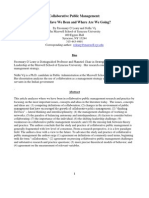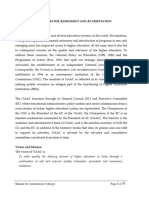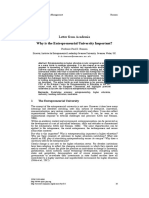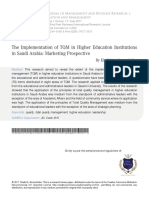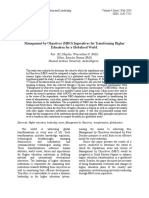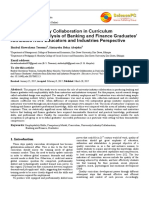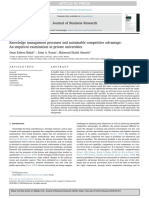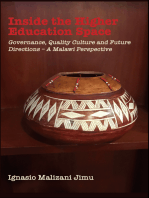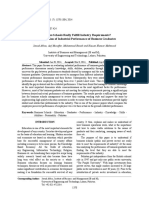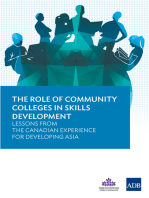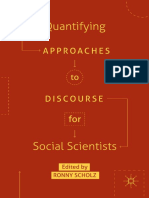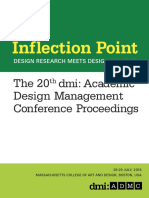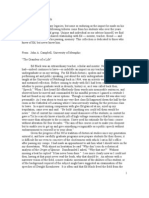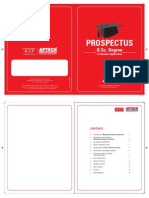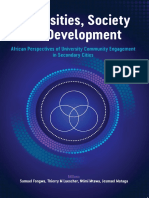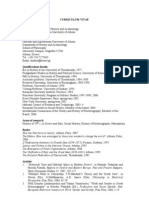Professional Documents
Culture Documents
A Critical Literature Review of World-Class Universities Characteristics, Enablers, and Strategies
Original Title
Copyright
Available Formats
Share this document
Did you find this document useful?
Is this content inappropriate?
Report this DocumentCopyright:
Available Formats
A Critical Literature Review of World-Class Universities Characteristics, Enablers, and Strategies
Copyright:
Available Formats
Volume 6, Issue 3, March – 2021 International Journal of Innovative Science and Research Technology
ISSN No:-2456-2165
A Critical Literature Review of World-Class
Universities: Characteristics, Enablers, and Strategies
Dr. Ahood Mohammad Alsawaha,
Faculty of Business Studies
Arab Open University
Dammam - Kingdom of Saudi Arabia
Adel Ismail Al-Alawi *
Prof., Department of Management & Marketing
College of Business Administration
University of Bahrain
Kingdom of Bahrain
*Corresponding Author
Odeh Al-Jayyousi
Prof., Department of Innovation and Technology Management
College of Graduate Studies,
Arabian Gulf University, Kingdom of Bahrain
Abstract:- Nations are keen to invest in quality education Besides, WCU defines a higher education institution (HEI) to
since it is the driver for economic growth and perform and disseminate knowledge and deliver quality
competitiveness. The concept of World-Class University teaching based on research (Baskaran, 2017). According to
(WCU) is inspired by both internationalization of higher Pillay (2011), HEI is a knowledge worker provider to foster
education and differentiation strategy. The paper aims to economic growth and progress.
shed light on the key features, enablers, and strategies for
WCS through a critical literature review. The The state of HEI is characterized by institutional inertia,
methodology is based on content analysis to devise sound budget constraints, and mature human capital. There is a
policies for developing WCU in GCC. The study reveals critique from policy circles that HEI is not delivering the
key attributes that define WCU in a global context. WCU needed human capital for the market. Consequently, there is
inspires universities to re-visit the value proposition and pressure from the community and government to reform
develop foresight to respond to market demands and education at all levels and respond to technological changes
policy agenda. Adopting WCU as a target and brand and market demands. Furthermore, in a digital era, technology
implies the need for digital transformation that will enables HEI to adopt new business models and innovation in
influence universities' structure and processes, which will teaching and learning pedagogy (Rof et al., 2020). Open
foster a new culture of excellence and innovation. The sources and e-learning are disrupting the conventional models
study recommends articulating a unique model for a WCU of HEI.
that is informed by local knowledge and culture.
The response is to enhance the HEI's organizational
Keywords:- World-class University (WCU), Education innovation to strengthen competitiveness and adopt new
Strategy, Higher Education, Education Quality, Knowledge- standards and targets using WCU as a key performance
based Economy, Gulf Cooperation Council (GCC). indicator. Realizing that nations' competitiveness is measured
by the quality of human capital and HEI, policymakers are
I. INTRODUCTION setting targets to establish WCU as part of the differentiation
strategy. This implies a transformation of the culture,
The “world-class” term refers to the objective of structure, processes, and strategy of HEI. Besides, this new
attaining and/or sustaining the competitiveness of the World- target of becoming a WCU necessitates the formulation of a
Class throughout the production of excellence accomplished new business model, new partnerships with industry and
by the top performs (Dudek, 2016). In the higher education community, and HEI's new roles.
context, world-class university (WCU) is reserved for top-
class universities among the top 100 in teaching and research.
IJISRT21MAR355 www.ijisrt.com 505
Volume 6, Issue 3, March – 2021 International Journal of Innovative Science and Research Technology
ISSN No:-2456-2165
According to Abonyi (2016), Higher Education Moreover, according to Loeb et al. (2017), the university
Institutions (HEIs) have a superior potential in changing any environment contains a set of complex infrastructure, which
economy by playing as one of the most significant effective includes 1) formal and informal networks, 2) government and
ways of knowledge transfer to students, graduates, and then to academic organizations, 3) support and professional services,
the country's economy. They perform an extremely vital role 4) capital sources and physical entrepreneurship structure, 5)
in the emerging knowledge society by contributing to a alumni engagement, 6) incubators, 7) prototype development
learning society's progress. Moreover, Ramakrishnan & Yasin services, 8) university startups seed funding, and 9)
(2012) stated that universities contribute to nationwide technology transfer services. Therefore, it is essential to
improvement by preparing graduates for future jobs. harness these resources to achieve high-quality education
Therefore, the country’s higher education institutions' linked to the national innovation system (NIS).
expectations will face more challenges (Al‐Alawi, Al‐
Marzooqi, & Mohammed, 2007; Hazelkorn, 2013; Alharbi, Also, as Bejinaru et al. (2016) revealed, a world-class
2016). Higher Education Institutions should then meet university has to play a role in the nations’ international
students’ and societies’ needs in light of their abilities and competitiveness by directly impacting life- quality and life-
interests (Chen et al., 2015). the level of their citizens. Therefore, if the need to compete is
now required in global higher education institutions, world-
Moreover, as Yusuf (2017) indicated, universities face a class university significance needs to be notable (Salmi,
continually changing and healthy competition in the education 2009).
market; therefore, there would be transformation and
challenges in the future educational system. Besides, they According to Altbach (2004), “Everyone wants a world-
need to identify the proper means to advance their class university, and no country feels it can do without one”.
performance to develop and adapt new business models, Moreover, higher education institutions in many regimes have
structures, and systems to align with the transformation plan been restructured. The world-class university has become the
and ensure sustainability. In terms of universities’ cure to guarantee the worldwide economic success based on
transformation process, leaders, academics, policymakers, and the top 20, 50 or 100 internationally-ranked universities’
other participants in the higher education area, are getting a characteristics (Mohrman 2008) argued. Therefore, to be
better understanding of how different related actors within the “world-class”, the university has to reach the standard
university could contribute to strategic visions and change included in the Lists of World university rankings, as Tayeb
processes. Moreover, harnessing networks' power is the key to (2016) declared.
ensuring organizational learning and building a shared vision,
as Intsiful (2015) stated. Additionally, university stakeholders Universities are considered the primary phase of
use rankings to influence their accreditation decisions, educational excellence in the knowledge-based economy. As
financing, sponsorship, and employee recruitment. Besides, changes happen worldwide and quickly in higher education,
they believe that rankings help to build their institutional the establishing of WCU becomes a supreme global
reputation and position. On the other hand, students are using requirement (Mehrotra, Elias, & Al-Alawi, 2019; Alhazmi &
rankings to “shortlist” their universities' choices (Hazelkorn, Yahmed 2017, Al-Alawi et al. 2019). Hence, governments
2013). should give more effort into constructing world-class systems
that provide a wide range of good quality higher education
However, the importance of higher education varies institutions with distinctive missions, as Salmi (2016) argued.
enormously between different nations. For example, countries
with ambitions to be ranked among developed countries pay Altbach (2015) stated a significant advantage from
great attention to improving their educational practices, debating on world-class universities, such as focusing on
procedures, and systems (Intsiful, 2015). improving the educational standards on universities' roles in
their society. Additionally, how higher education institutions
Accordingly, the higher education sector leaders are re- can fit in the country's higher education system and the global
evaluating their strategy and policy to cope with worldwide academic world. Besides, a world-class university notion
dynamics, complexity, growth, and expenditure to co-create reveals the world’s leading research-oriented educational
models of World-class universities. At the same time, WCU institutions' values and norms. For that reason, it is not
plays an essential role in training scientists, professionals, compelling for universities to struggle for excellence and
high-level specialists, and researchers. Therefore, the economy competition, which would inspire organizational innovation.
needs this type of model to produce new knowledge that But, this struggle is difficult when it comes to measuring
supports the national innovation system (Aturupane,2009). academic quality and accomplishment. Thus, “it might well
Furthermore, according to Söderberg et al. (2017), as be the case that the innovative higher educational energies and
innovation includes a set of dimensions, their main challenge resources should be focused on more realistic and perhaps
is to create an education system with an enabling environment more useful goals". The study by Al-Jayyousi, Al-Alawi, Al-
that can develop human resources’ capabilities. Mahamid, & Bugawa (2019) recommended integrating
organizational innovation to adopt entrepreneurship, strategic
IJISRT21MAR355 www.ijisrt.com 506
Volume 6, Issue 3, March – 2021 International Journal of Innovative Science and Research Technology
ISSN No:-2456-2165
innovation, and learning at HEI. building first-class universities is to "train high-level creative
talent, turn out high-standard, original research results, and
Furthermore, there are several motives for building and make outstanding contributions to society". While in
achieving world-class universities, and the main reason is the Germany, Korea, and Japan, the government provided
need for qualified, professional, and educational requirements excellent initiatives to build a world-class university to
in Higher Education Institutions' outcomes. Moreover, there is emphasize the significance of research as a principal
an increasing reflection from the globalization on our benchmark on the reputation of their institutions. However,
societies, economy, and labor markets, which will require the author stated that although teaching is usually mentioned
higher education to provide a suitable readiness and ground as an element of a great university, it is seldom cited as a
for their graduates to meet this demand. Moreover, to achieve prime initiative for having a world-class university.
the goal of building the university into a world-class level, the
university has to adopt strategies in management and Meanwhile, the first noticeable variance in a world-class
governance, funding, students' and researchers’ talents university definition is to agree upon a naming. Therefore,
attraction, infrastructure, research, and internationalization, as some refer to "flagship universities" (Bunting et al., 2014;
argued by Boamah (2014). Douglas 2014; & Yonezawa 2007), others use the term
internationally recognized “research universities” Levin, 2010;
The critical literature review will start by raising a set of Saaid, 2014, & Rosovsky 2014). At the same time, Marginson
key questions in Research Scope and Questions; then, World- (2012) uses "super brands" to refer to the top six universities
Class University classifications will address definitions, in higher education rankings. However, the majority use
enablers, and strategies for WCU; and finally will outline "world-class university" (Atlbach, 2005; Altbach & Balan,
conclusions and recommendations. 2007; Salmi 2009; Shin 2009; Rhee 2011; Yang & Welch,
2012, Al-Alawi, 2019). However, the most common
Research Scope and Questions definition from all these different meanings is "a university
Many researchers addressed WCU from different angles. commonly held to be one of the best in the world".
This literature review's scope will be focused on definitions,
characteristics, enablers, and strategies for WCU. Key Furthermore, Altbach (2015) defines WCU as a “Top
questions about WCU will attempt to the critical attributes of rank university based on excellence in research, academic
WCU based on content analysis from databases, published freedom, a sense of intellectual excitement, governance (the
papers, online doctoral thesis, and books from 2009 to 2019. academic community has control over the central elements of
The questions are: academic life), adequate facilities, and adequate funding.”
1. What is the definition of world Class University? Moreover, Aula and Tienari (2011) stated that it is the
2. What are the characteristics of a world-class university? university that permeated the reputation-building.
3. What are the fundamental strategies in the road to world-
class universities? On the other hand, world-class universities were defined
4. What are university rankings? by Wang et al. (2013) as “Universities which produce
transformational research outputs and develop nation’s
World-Class University competitiveness in the global knowledge economy are World‐
This section covers the definition, characteristics, and Class Universities.” Additionally, Salmi (2009) described
basic strategies in the road to world-class universities, WCU as an operating environment that inspires managerial
university rankings, and the Arab research universities' independence and innovation, while Salmi (2016)
situation. acknowledged the status of a world-class university based on
international recognition. Although the world-class status goal
The Definition of World Class University is clear, still the world-class status definition is not yet clear
According to Ruby (2014), there are some considerable (Huisman, 2008) concluded.
differences between World Class University definitions, plus,
these differences in the definitions are in the primary purposes Table 1 summarizes some concepts from the mentioned
for obtaining world-class universities. For example, in China, definitions from the literature.
IJISRT21MAR355 www.ijisrt.com 507
Volume 6, Issue 3, March – 2021 International Journal of Innovative Science and Research Technology
ISSN No:-2456-2165
STUDY
CONCEPTS
Universities engaged in teaching, research, and services Baskaran (2005)
Top-class universities Baskaran & Balan (2007)
Rank among the top 100 universities Baskara(2017); Bunting, Cloote & Schalkwyk (2014)
Flagship universities Douglas (2014); Saaid (2014); Yonezawa (2007)
Research universities Levin (2010); Levin (2010); Rosovsky (2014)
Superbrands universities Marginson (2012)
World-class university Atlbach (2005); Altbach & Balan (2007); Shin (2009); Salmi
(2009); Rhee (2011); Yang & Welch (2012)
One of the best universities in the world Salmi (2009)
Reputation-building university Aula & Tienari (2011)
Global knowledge economy nation’s competitiveness developer Wang Et Al. (2013)
university
International recognition Salmi (2016)
Excellent in research, academic freedom, intellectual interest, Bunting, Cloote & Schalkwyk (2014)
governance, and funding
Universities inspire managerial independence and “innovation.” Salmi (2009)
International recognition universities Altbach (2015)
Table 1: Concepts used to define the world-class university
Word-class University Definition: While Fu et al. (2018) indicated, the pursuit of world-class
Table 1 illustrate the concepts used to define a world- universities depended on globalization logics in the university,
class university. The working definition of a World-class which showed through competition encouragement,
university is a university with a solid commitment to effectiveness and performance, excellence, and high return
excellence in the quality of processes, inputs, and outputs. rates. Moreover, it has to be presented on how educational and
Besides, it is a supreme development in the domain of economic policies are discussed in the university system and
international higher education, which places it at the center of affect higher education governance and academics' minds.
international higher education policies. Moreover, it becomes
critical in driving economic growth and providing insights to Murdowo (2018) mentioned, benchmarking and
globally competitive institutions and higher education international cooperation, academic autonomy, governance,
transformations. government subsidies, university management, autonomous
and independent are factors for attaining a World-Class
The Characteristics of World Class University University. However, Rabossi & Salto (2018) specified that
As Huisman (2008) concluded, worldwide universities presence of a critical mass of International top students and
stand higher on many stakeholders’ plans and agendas outstanding faculty, Sources of financing, and the degree of
worldwide. Moreover, it is supposed to have a significantly academic and managerial autonomy in the university are the
ranked research output, excellent facilities, high ranked factors in building World-Class University. Additionally,
research output, a name that exceeds the local boundaries, and Ruby (2014) considered, 1) shared governance with a collegial
a culture of excellence (Douglass, 2016). Therefore, there is a administrative style, 2) academic freedom, 3) merit selection
need to study some features that are likely to impact higher of students and faculty, 4) significant human contact “real as
education institutions on their path to constructing a world- opposed to virtual encounters between student and teachers",
class university, as argued by Boamah (2014). 5) preservation and transmission of culture as one of its
missions; and 6) non-profit status, as a set of six
Moreover, Salmi (2009) offered a small number of characteristics of the top research university.
generalities in defining “world-class university”: “abundant
resources,” “high concentration of talent,” and an operating Furthermore, Altbach (2004) Suggested some world-
environment that inspires managerial independence and class universities' characteristics, including Freedom in
“innovation”. Douglas (2016) considered some “generic but academics and an environment that is stimulating
informative traits” guiding and advising institutions’ leaders. intellectually, excellence in research, self-governance
IJISRT21MAR355 www.ijisrt.com 508
Volume 6, Issue 3, March – 2021 International Journal of Innovative Science and Research Technology
ISSN No:-2456-2165
internally, and sufficient funding and services. Besides stated, Therefore, it is crucial to understand WCU
“Everyone wants a world-class university. No country feels it characteristics for the entire academic communities and
can do without one”. However, Mohrman (2008) declared especially for those who are having a structural position in the
that although the world-class status goal is clear, still the university to have the ability to evaluate the university
world-class status description is not yet clear. As stated by performance. Moreover, it will allow them to formulate
Altbach (2009); Liu (2009); Wende (2009), world-class policies and programs that will direct all the university
universities are committed to the creation and dissemination of resources to perform continuous improvements to realize
knowledge in a range of disciplines and fields; the delivery of WCU. Hence, according to the above studies, Table 2
elite education at all levels; serving national needs, and illustrates some characteristics of WCU, which have been
furthering the international public good. summarized from the previous literature.
Table 2: Summary of the characteristics of WCU (Researcher)
Characteristics Authors
Proper leadership Altbach and Salmi (2011); Salmi (2016); Fu et al. (2018); Ramakrishna & Yasin (2012)
vision Altbach and Salmi (2011); Rabossi & Salto (2018); Ramakrishna & Yasin (2012)
talent Boamah (2014)
resources Altbach and Salmi (2011); Ramakrishna & Yasin (2012)
governance Altbach and Salmi (2011); Ramakrishna & Yasin (2012); Boamah (2014); Fu et al. (2018); Rabossi & Salto
(2018
innovation Altbach and Salmi (2011); Ramakrishna & Yasin (2012); Douglass (2014); Boamah (2014); Fu et al.
(2018);
internationalization Altbach and Salmi (2011); Ramakrishna & Yasin (2012); Douglass (2014); Boamah (2014); Fu et al.
(2018);
culture of excellence Altbach and Salmi (2011); Ramakrishna & Yasin (2012); Douglass (2014); Fu et al. (2018)
Some lessons related to WCU characteristics can be Basic strategies in the road to world-class universities
drawn from Table 2. The main features of WCU depend on According to Kakuchi (2015), the government’s role has
the university governance, vision, culture of excellence, and a critical impact on fostering world-class universities'
innovation in addition to the quality of its input, process, and development more than before due to their high research
output (i.e., the quality of its leaders, instructors, employees, facilities and capacity costs. However, currently, an
accommodations, fund supply, education, learning, research, environment encouraging strategies and initiatives from the
graduates, infrastructure, academic culture, and other public is needed to create a world-class university. There are
resources). Moreover, other WCU characteristics are the three basic strategies, which were identified from the
development of the university's intellectual atmosphere locally International experience, in establishing world-class
and globally. universities.
Table 3: Summary of Approaches for basic Strategies to Establish World-Class Universities (adapted from Kakuchi, 2015).
Approaches to Establish World-Class Characteristics Countries
Universities
Upgrade existing universities Adopted most regularly by governments China has adopted the approach
Significantly cheaper than the third approach since the early 1980s.
Encouraging existing institutions to Challenging to manage effectively and often does not France and Denmark adopted the
unite and change into merged reach the expected outcomes approach in recent years.
universities Merging universities on a regional foundation or
through an innovation fund from the government to
reward similar institutions merging
Building a new world-class university Make it possible to operate the new universities with Kazakhstan and India adopted
from scratch unconstrained financial funds and with a non-traditional the approach.
university’s cultural influence on people
The best approach in countries that prevent traditional
universities from being innovative
IJISRT21MAR355 www.ijisrt.com 509
Volume 6, Issue 3, March – 2021 International Journal of Innovative Science and Research Technology
ISSN No:-2456-2165
Some lessons related to the approaches for basic approaches can be learned from international practices.
strategies to establish World-Class Universities can be drawn Consequently, all these lessons will help the universities move
from Table 3. There is no universal recipe for “building” a in the proper direction, either through upgrading or merging
world-class university. It all depends on each country's existing institutions to creating new institutions altogether or
circumstances, culture, and institutional models, which are by building a new world-class university from scratch.
different. Therefore, any country has to choose a strategy that However, Altbach and Salmi (2011) identified several
will be suitable to play within its resources and strengths. “accelerating factors” through policy research, which can play
However, many lessons about resource richness, flexible a progressive role in building World-Class Universities,
governance engagements, great attention to talents successful summarized in Table 4.
Table 4: Summary of acceleration factors that can play a positive role in building world-class universities (researcher adapted from
Altbach and Salmi 2011)
Acceleration Factors in Building World-
Class Universities Description
The first factor is to depend on the Fairly constructing the institution's educational power.
concentration on bringing large numbers of Examples: South Korea and Hong Kong
overseas scholars to their country.
The second factor is using English as the Significantly enhancing the ability of the institution to attract very qualified graduate
primary university language. students and foreign academics. Examples: Singapore
The third factor is the concentration on Achieving a critical mass more rapidly.
niche areas. Examples: South Korea, Hong Kong, Russia, and London
The fourth factor is the concentration on Guiding the institution in its improvement efforts
the use of benchmarking. Examples: Shanghai Jiao Tong University, which carefully compared its strategic
planning work to the leading Chinese universities. Therefore, currently, the famous
World Universities Academic Rankings are recognized as the “Shanghai rankings,”
which have emerged from such benchmarking efforts.
The fifth factor is the introduction of Curriculum and pedagogical innovations, such as teaching and research integration and
educational innovations and a significant establishing a supportive digital library.
curriculum. These innovative features are essential for new institutions to attract students away from
the existing universities and get the risk of being enrolled in an “unknown” program.
Examples: Hong Kong, US, Russian, and British models.
The sixth factor worth emphasizing is the Inspiring leadership, self-assessment, and monitoring to continuously recognize
need to remain alert and maintain a sense dysfunctions or threats, the capability of swift action to address them, and the readiness
of determination to avoid complacency. to continually explore improvement areas.
Some lessons related to acceleration factors that can play outcomes value, significantly connected with career
a positive role in building World-Class Universities can be opportunities and education qualifications. Therefore, there
drawn from Table 4. Higher education institutions need to was a need for the existence of higher education rankings, and
stay aware, responsive, and sustain a sense of determination to its arrival was not surprising.
develop their World-Class status.
Hence, higher education leaders and decision-makers in
World Class University rankings today’s world became more aware of identifying, defining,
In higher education, university ranking is not a new and designing their strategies and ambitions according to
phenomenon; it is progressively has become distinguished in universities' global ranking. Consequently, higher education
the system of higher education all around the whole world in institutions can create a comprehensive profile that allows
the last three decades, mainly the most recent decade (Brian, them to recognize their weaknesses, strengths and measuring
2013). their approaches and execution according to indicators
belonging to several leading global rankings. Such main
According to Hazelkorn (2013), recently, higher global rankings are different in their data collecting way and
education faces many fast challenges such as individual, methodologies. Moreover, Main Global Rankings differ in
social, cultural, and economical quick changes due to the need their type of ranking; for example, some concentrate on
for rapid new knowledge creation. Besides, countries need to research only, while others focus on producing league tables,
have the ability to develop talent. Moreover, higher education while the rest are doing Multirankings without producing
institutions' governance and management have an essential league tables (Haupt, 2016). Table 5 shows the Main Global
core role in the productive economy and the universities’ Rankings in the world.
IJISRT21MAR355 www.ijisrt.com 510
Volume 6, Issue 3, March – 2021 International Journal of Innovative Science and Research Technology
ISSN No:-2456-2165
Table 5: Main global rankings (researcher adapted from Haupt, 2016)
Main Global Rankings Starting Date
Academic Ranking of World Universities [ARWU] (Shanghai Jiao Tong University) 2003
Webometrics (Spanish National Research Council) 2003
World University Ranking (Times Higher Education/Quacquarelli Symonds) 2004–2009
Performance Ranking of Scientific Papers for Research Universities (HEEACT) 2007
Leiden Ranking (Centre for Science & Technology Studies, University of Leiden) 2008
World’s Best Colleges and Universities (US News and World Report) 2008
SCImago Institutional Rankings 2009
Global University Rankings, RatER (Rating of Educational Resources, Russia) 2009
Top University Rankings (Quacquarelli Symonds) 2010
World University Ranking (Times Higher Education/Thomson Reuters [THE-TR] 2010
U-Multirank (European Commission 2011
Some lessons related to the leading global rankings can REFERENCES
be drawn from Table 5. There is no comprehensive table
describing such world rankings; moreover, the value of those [1]. Abonyi, U. K. (2016). Universities' Role in Regional
differences between the leading global rankings outcomes lies Development: A Case Study of University for
in their analysis. Development Studies, Ghana. Journal of Education and
Practice, 7(26), 11-20.
II. CONCLUSIONS AND IMPLICATIONS [2]. Al-Alawi, A. I., Abdulmohsen, M., Al-Malki, F. M., &
Mehrotra, A. (2019). Investigating the barriers to change
In conclusion, since universities are deeply embedded in management in public sector educational
their nations, they must reform and align their strategies to institutions. International Journal of Educational
foster national development goals. The notion of WCU Management. 33(1), 112-148.
emerged as a response of policymakers to improve HEI and https://doi.org/10.1108/IJEM-03-2018-0115
enhance HEI's quality and competitiveness. The adoption of a [3]. Al‐Alawi, A. I., Al‐Marzooqi, N. Y., & Mohammed, Y.
WCU entails a transformative vision of organizational culture, F. (2007). Organizational culture and knowledge
structure, and strategy. WCU may be viewed as a sharing: critical success factors. Journal of knowledge
transformative vision for nations to set new standards for management. 4(20), 227-246,
higher education. This is critical due to disruptive technologies https://doi.org/10.1108/13673270710738898
and globalization, where knowledge workers are likely to be [4]. Albastaki, Y. A., Al-Alawi, A. I., & Albassam, S. A.
replaced by machines. Hence, WCU entails a new philosophy (2019). Knowledge Management Technologies,
of teaching and learning that fosters lifelong learning and Applications, and Implementation in the Public Sector:
critical thinking. An Explorative Review. In Handbook of Research on
Implementing Knowledge Management Strategy in the
At the strategic level, WCU presents a differentiation Public Sector (pp. 1-17). IGI Global.
strategy that emphasizes excellence and innovation at all [5]. Alharbi, E. A. (2016). Higher Education in Saudi Arabia:
levels, including global partnerships, technology adoption, Challenges to Achieving World-Class Recognition.
enabling environment, teaching methods, funding model, International Journal of Culture and History, 2(4), 169-
linkage with industry, R&D, and patents. WCU inspires HEI 172. https://doi.org/10.18178/ijch.2016.2.4.058
to re-visit the value proposition at the business model [6]. Alhazmi A, & Yahmed, M.S.B. (2017). World Class
innovation arena and develop foresight to respond to market Universities in Saudi Arabia: Barriers and perspectives.
demands and policy agenda. At the organizational innovation Academia Journal of Educational Research, 5(9): 236-
dimension, the adoption of WCU as a target and brand implies 246, DOI: 10.15413/ajer.2017.0244.
the need for digital transformation that will influence [7]. Al-Jayyousi, O., Al-Alawi, A., Al-Mahamid, S., &
universities' structure and processes, which will foster a new Bugawa, A. (2019). Entrepreneurial University and
culture of excellence and innovation. Organizational Innovation: The Case of Arabian Gulf
University, Bahrain. In Management and Administration
of Higher Education Institutions at Times of Change.
Emerald Publishing Limited
IJISRT21MAR355 www.ijisrt.com 511
Volume 6, Issue 3, March – 2021 International Journal of Innovative Science and Research Technology
ISSN No:-2456-2165
[8]. Altbach, P. (2004). The Costs and Benefits of World- [22]. Douglass, J. A. (2014). PROFILING THE FLAGSHIP
Class Universities. Academe, 90(1), 20-23. UNIVERSITY MODEL: An Exploratory Proposal for
doi:10.2307/40252583 Changing the Paradigm from Ranking to Relevancy*.
[9]. Altbach, P. G. (2005). “India: World Class UC Berkeley: Center for Studies in Higher Education.
Universities?” International Higher Education 40 Retrieved from
(Summer): 18–20. https://escholarship.org/uc/item/8kn1m9dz
[10]. Altbach, P. G. (2015). What Counts for Academic [23]. Douglass, J.A. (Ed.) (2016). The New Flagship
Productivity in Research Universities? International University: Changing the Paradigm from Global
Higher Education, (79), 6-7. Rankings to National Relevancy. Basingstoke: Palgrave
https://doi.org/10.6017/ihe.2015.79.5837 Macmillan.
[11]. Altbach, P. G., & Balán, J. (Eds.). (2007). World class [24]. Dudek, Marek. (2016). Generations of the world-class
worldwide: Transforming research universities in Asia manufacturing systems
and Latin America. JHU Press. [25]. Fu, Y., Baker, D.P. & Zhang, L. Engineering a World
[12]. Altbach, P. G., & Salmi, J. (Eds.). (2011). The road to Class University? The Impact of Taiwan’s World Class
academic excellence: The making of world-class University Project on Scientific Productivity. High Educ
research universities. The World Bank. Policy 33, 555–570 (2020).
[13]. Altbach, P.G. (2009). Peripheries and centers: research https://doi.org/10.1057/s41307-018-0110-z
universities in developing countries. Asia Pacific Educ. [26]. Haupt, S. (2016). Factors influencing innovation
Rev. 10, 15–27 (2009). https://doi.org/10.1007/s12564- adoption in a higher education institution (Doctoral
009-9000-9 dissertation, University of Pretoria).
[14]. Aturupane, H., & Millot, B. (2009). The towers of [27]. Hazelkorn, E. (2013). World-class universities or world-
learning: performance, peril, and promise of higher class systems? Rankings and higher education policy
education in Sri Lanka (No. 50774, pp. 1-138). The choices. Rankings and accountability in higher
World Bank. education: Uses and misuses, 71-94.
[15]. Aula, H. and Tienari, J. (2011), "Becoming “world‐ [28]. Huisman, J. (2008). World-class universities. Higher
class”? Reputation‐building in a university merger", Education Policy, 21, 1–4.
critical perspectives on international business, Vol. 7 No. [29]. Intsiful, E. (2015). Actors Interpretations and Change
1, pp. 7-29. Process: The Case of University of Ghana's Strategic
https://doi.org/10.1108/17422041111103813. Vision of becoming a World Class University (Master's
[16]. Baskaran, A. (2017). UNESCO Science Report: thesis).
Towards 2030. Institutions And Economies, , 125-127. [30]. Kakuchi, S. (2015). Restrictions on collaboration are
Retrieved from https://ijie.um.edu.my/article/view/5039 hindering international research. University World
[17]. Bejinaru, R., & Prelipcean, G. (2017). Successful News, 9.
strategies to be learnt from world-class universities, [31]. Levin, R. C. (2010). Top of the class: The rise of Asia's
Proceedings of the International Conference on Business universities. Foreign Affairs, 63-75.
Excellence, 11(1), 350-358. DOI: [32]. Loeb, S., Dynarski, S., McFarland, D., Morris, P.,
https://doi.org/10.1515/picbe-2017-0037 Reardon, S., & Reber, S. (2017). Descriptive Analysis in
[18]. Boamah, K. W. A. M. E. (2014). The Prospects and Education: A Guide for Researchers. NCEE 2017-4023.
Challenges of Building a World Class University in a National Center for Education Evaluation and Regional
Globalized World: The Case of the University of Ghana Assistance.
(Doctoral dissertation, University of Ghana). [33]. Marginson, S. (2010). Higher education in the global
http://ugspace.ug.edu.gh/handle/123456789/21409 knowledge economy. Procedia-Social and Behavioral
[19]. Brian Pusser & Simon Marginson (2013) University Sciences, 2(5), 6962-6980.
Rankings in Critical Perspective, The Journal of Higher https://doi.org/10.1016/j.sbspro.2010.05.049
Education, 84:4, 544-568, DOI: [34]. Mehrotra, A, Elias, H & Al-Alawi, A.I (2019) The
10.1080/00221546.2013.11777301 Power of Knowledge Sharing in Public Higher
[20]. Bunting, I., Cloete, N., & van Schalkwyk, F. (2014). An Education: A Case of X G.C.C. Public University.
Empirical Overview of Eight Flagship Universities in Chapter 16 in Book, Handbook of Research on
Africa. A Report of the Higher Education Research and Implementing Knowledge Management Strategy in the
Advocacy Network in Africa (HERANA). Cape Town: Public Sector, edited by Albastaki, Y. A., Al-Alawi, A.
Center for Higher Education Transformation (CHET). I., & Abdulrahman Al-Bassam, S. Chapter 1. Hershey,
[21]. Chen, I. S., Chen, J. K., & Padro, F. F. (2017). Critical PA: IGI. Global. doi:10.4018/978-1-5225-9639
quality indicators of higher education. Total Quality [35]. Mohrman, K. The Emerging Global Model with Chinese
Management & Business Excellence, 28(1-2), 130-146. Characteristics. High Educ Policy 21, 29–48 (2008).
https://doi.org/10.1080/14783363.2015.1050178 https://doi.org/10.1057/palgrave.hep.8300174
IJISRT21MAR355 www.ijisrt.com 512
Volume 6, Issue 3, March – 2021 International Journal of Innovative Science and Research Technology
ISSN No:-2456-2165
[36]. Murdowo, D. (2018). In What Ways University in [51]. Wang Q., Cheng Y., Liu N.C. (2013) Building World-
Indonesia as World-Class University Can Produce a Class Universities. In: Wang Q., Cheng Y., Liu N.C.
Global Competitive Human Capital (Case Study: (eds) Building World-Class Universities. Global
Telkom University). International journal of humanities Perspectives on Higher Education, vol 25.
and social science, 8. DOI: 10.30845/ijhss. v8n6a5 SensePublishers, Rotterdam.
[37]. Pillay, P., & Oberholzer, R. (2011). Pundy Pillay Higher https://doi.org/10.1007/978-94-6209-034-7_1
Education and Economic Development Literature [52]. Yang, R., Welch, A. A world-class university in China?
review. The case of Tsinghua. High Educ 63, 645–666 (2012).
[38]. Rabossi, M., & Salto, D. (2018). The Weight of https://doi.org/10.1007/s10734-011-9465-4
Tradition. In Pursuit of World-Class Universities: A [53]. Yonezawa, A. Japanese flagship universities at a
Global Experience, 91. crossroads. High Educ 54, 483–499 (2007).
[39]. Ramakrishnan, K., & Yasin, N. M. (2012). Knowledge https://doi.org/10.1007/s10734-006-9028-2
management system and higher education institutions. [54]. Yusuf, N. (2017). Changes Required in Saudi
International Proceedings of Computer Science and Universities Curriculum to Meet the Demands of 2030
Information Technology, 37(1), 67-71. Vision. International journal of economics and finance,
https://www.springer.com/gp/book/9783642345302 (9)111-116. https://doi.10.5539/ijef. v9n9p111
[40]. Rhee, B. S. (2011). “A World-Class Research University
on the Periphery: The Pohang University of Science and
Technology, the Republic of Korea”, in P. G. Altbach &
J. Salmi (eds), The Road to Academic Excellence: The
Making of World-class Research Universities, World
Bank, Washington DC.
[41]. Rof, A., Bikfalvi, A., & Marquès, P. (2020). Digital
Transformation for Business Model Innovation in Higher
Education: Overcoming the Tensions. Sustainability,
12(12), 4980. doi:10.3390/su12124980.
[42]. Rosovsky, H. (2014). Research Universities: American
Exceptionalism? International Higher Education, (76), 4-
6. https://doi.org/10.6017/ihe.2014.76.5519
[43]. Ruby, A. (2014). The Quest for a World Class
University: Defining the Goal for an Emerging
Economy.
[44]. Saaid, A.H.M. (2014). Research Universities to Propel
Malaysia into a Developed Nation
www.bernana.com.my/v7/fe/newsfatrues
[45]. Salmi, J. (2009). The challenge of establishing world
class universities. The World Bank.
[46]. Salmi, J. (2016). Excellence Initiatives to Create World-
Class Universities. International Higher Education, (87),
17-18. https://doi.org/10.6017/ihe.2016.87.9506
[47]. Serdyukov, P. (2017), "Innovation in education: What
works, what doesn’t, and what to do about it?", Journal
of Research in Innovative Teaching & Learning, 10 (1),
4-33. https://doi.org/10.1108/JRIT-10-2016-0007.
[48]. Shin, J. (2009). Building World-Class Research
University: The Brain Korea 21 Project. Higher
Education, 58(5), 669-688. Retrieved October 23, 2020,
from http://www.jstor.org/stable/25622142
[49]. Söderberg, J., & Delfanti, A. (2015). Hacking Hacked!
The Life Cycles of Digital Innovation. Science,
Technology, & Human Values, 40(5), 793–798.
https://doi.org/10.1177/0162243915595091
[50]. Tayeb O. (2016) Roadmap to Become a World-Class
University. In: Tayeb O., Zahed A., Ritzen J. (eds)
Becoming a World-Class University. Springer, Cham.
https://doi.org/10.1007/978-3-319-26380-9_1
IJISRT21MAR355 www.ijisrt.com 513
You might also like
- Collaborative NetworksDocument37 pagesCollaborative NetworksAlan LavoignetNo ratings yet
- Collaborative Public Management - O'Leary and Vij (ASPA Conf 2012)Document34 pagesCollaborative Public Management - O'Leary and Vij (ASPA Conf 2012)John Kamensky100% (2)
- Institutional Transformation R PDFDocument18 pagesInstitutional Transformation R PDFlastriNo ratings yet
- Perbandingan Daya Saing Indonesia Diantara Negara-Negara ASEANDocument15 pagesPerbandingan Daya Saing Indonesia Diantara Negara-Negara ASEANsubroto rapihNo ratings yet
- Nature of Technology: "Purposeful Intervention by Design"Document2 pagesNature of Technology: "Purposeful Intervention by Design"Angeline ParfilesNo ratings yet
- Delegate Preparation Guide: Harvard Model United Nations IndiaDocument23 pagesDelegate Preparation Guide: Harvard Model United Nations IndiaRithvikNo ratings yet
- Green HRM Practices ReviewedDocument6 pagesGreen HRM Practices ReviewedHussni100% (1)
- Executive SummaryDocument33 pagesExecutive SummarySazedul EkabNo ratings yet
- Taylorism vs. FordismDocument2 pagesTaylorism vs. FordismLiv Maloney67% (3)
- A Guidebook To The Green Economy Issue 4: A Guide To International Green Economy InitiativesDocument52 pagesA Guidebook To The Green Economy Issue 4: A Guide To International Green Economy InitiativesPUSTAKA Virtual Tata Ruang dan Pertanahan (Pusvir TRP)No ratings yet
- Infrastructure For Economic Development and Poverty Reduction in AfricaDocument108 pagesInfrastructure For Economic Development and Poverty Reduction in AfricaUnited Nations Human Settlements Programme (UN-HABITAT)100% (4)
- Market-Based Management (MBM) Approach To Success in Higher Education: Lessons From A Mid-Sized Business InstituteDocument15 pagesMarket-Based Management (MBM) Approach To Success in Higher Education: Lessons From A Mid-Sized Business InstituteGlobal Research and Development ServicesNo ratings yet
- Guidelines for Assessment and AccreditationDocument83 pagesGuidelines for Assessment and Accreditationpleasename1No ratings yet
- Case 24 King Saud UniDocument21 pagesCase 24 King Saud UniKad SaadNo ratings yet
- A. G A A: Uidelines For Ssessment and CcreditationDocument83 pagesA. G A A: Uidelines For Ssessment and Ccreditationritesh rachnalifestyleNo ratings yet
- Manual of Naac For Affiliated CollegesDocument89 pagesManual of Naac For Affiliated CollegesIndurElectricalsNo ratings yet
- Issues, Perceptions, and Challenges of Amalgamation in Higher Education InstitutionsDocument10 pagesIssues, Perceptions, and Challenges of Amalgamation in Higher Education InstitutionsIOER International Multidisciplinary Research Journal ( IIMRJ)No ratings yet
- Manual_for_autonomous_college- Guidelines for Assessment and Accreditation 05-12-2012Document77 pagesManual_for_autonomous_college- Guidelines for Assessment and Accreditation 05-12-2012drNo ratings yet
- Hannon - 2013 - Why Is The Entrepreneurial University Important?Document8 pagesHannon - 2013 - Why Is The Entrepreneurial University Important?Jeronimo SantosNo ratings yet
- Role of The Government in The Establishment of World-Class Universities in ChinaDocument15 pagesRole of The Government in The Establishment of World-Class Universities in ChinaDiệp TửNo ratings yet
- 6683 18991 1 PBDocument11 pages6683 18991 1 PBwegipawNo ratings yet
- The Implementation of TQM in Higher Education Institutions in Saudi Arabia: Marketing ProspectiveDocument9 pagesThe Implementation of TQM in Higher Education Institutions in Saudi Arabia: Marketing ProspectiveKeenan WekesaNo ratings yet
- Innovations in Knowledge and Learning for Competitive Higher Education in Asia and the PacificFrom EverandInnovations in Knowledge and Learning for Competitive Higher Education in Asia and the PacificNo ratings yet
- Tamansiswa Accounting Journal International: Volume 1, No 1, April 2021From EverandTamansiswa Accounting Journal International: Volume 1, No 1, April 2021No ratings yet
- Journal of Quality Assurance for Higher Education Institutions in Malawi: Book IiFrom EverandJournal of Quality Assurance for Higher Education Institutions in Malawi: Book IiNo ratings yet
- Are Moroccan Universities Ready For Knowledge ManagementDocument12 pagesAre Moroccan Universities Ready For Knowledge ManagementThe IjbmtNo ratings yet
- Innovations in Knowledge and Learning: Postsecondary Education Reform to Support Employment and Inclusive GrowthFrom EverandInnovations in Knowledge and Learning: Postsecondary Education Reform to Support Employment and Inclusive GrowthNo ratings yet
- Management by Objectives (MBO) Imperatives For Transforming Higher Education For A Globalised WorldDocument12 pagesManagement by Objectives (MBO) Imperatives For Transforming Higher Education For A Globalised WorldBekele Guta GemeneNo ratings yet
- Changes in the Higher Education Sector: Contemporary Drivers and the Pursuit of ExcellenceFrom EverandChanges in the Higher Education Sector: Contemporary Drivers and the Pursuit of ExcellenceNo ratings yet
- 1 s2.0 S1877042815039452 MainDocument10 pages1 s2.0 S1877042815039452 MainChristianov Ardani Sulistyo christianovardani.2019No ratings yet
- 1 s2.0 S2199853122010381 MainDocument18 pages1 s2.0 S2199853122010381 MainRia JebenkNo ratings yet
- Impact of the Qualities of the Manager ADocument8 pagesImpact of the Qualities of the Manager AIlker CetinNo ratings yet
- Reshaping University 6935Document12 pagesReshaping University 6935smkbaburroyyanNo ratings yet
- I J C R B Strategic Analysis of Public Sector Universities in PakistanDocument13 pagesI J C R B Strategic Analysis of Public Sector Universities in PakistanHamza KhanNo ratings yet
- Activity Based Costing (Abc) Model for Higher Education Institutions: A Basic Guide to the Model DevelopmentFrom EverandActivity Based Costing (Abc) Model for Higher Education Institutions: A Basic Guide to the Model DevelopmentNo ratings yet
- Fridah Theuri: (MSC Business Administrations Finance of Jomo Kenyatta University of Agriculture and Technology)Document21 pagesFridah Theuri: (MSC Business Administrations Finance of Jomo Kenyatta University of Agriculture and Technology)Novah KhaliraNo ratings yet
- 10 11648 J Edu 20170602 13 PDFDocument7 pages10 11648 J Edu 20170602 13 PDFSAYED FARAZ ALI SHAHNo ratings yet
- Case StudyDocument13 pagesCase StudySunny RajNo ratings yet
- The Four IsDocument12 pagesThe Four Ismona_bm_863142No ratings yet
- NAAC SSR For Affiliated CollegesDocument195 pagesNAAC SSR For Affiliated CollegesStephen MooreNo ratings yet
- Akareem, Hossain - 2016 - Open Review of Educational Research - Determinants of Education Quality What Makes Students' Perception DifferentDocument17 pagesAkareem, Hossain - 2016 - Open Review of Educational Research - Determinants of Education Quality What Makes Students' Perception DifferentPauloParenteNo ratings yet
- Fpe Convocation LectureDocument21 pagesFpe Convocation LectureAdeniji OlusegunNo ratings yet
- TEMJournalMay2020 770 778Document10 pagesTEMJournalMay2020 770 778Ahmad Giant TNo ratings yet
- Ref of Kmo and AlphaDocument21 pagesRef of Kmo and AlphaHoneyia SipraNo ratings yet
- Competitive Intelligence Networks For Higher EducationDocument8 pagesCompetitive Intelligence Networks For Higher EducationsalahNo ratings yet
- The Possibility of Applying Total Quality Management at The Higher Institute of Science and Technology - SUSADocument6 pagesThe Possibility of Applying Total Quality Management at The Higher Institute of Science and Technology - SUSAInternational Journal of Innovative Science and Research TechnologyNo ratings yet
- Is Teacher Education at Risk A Tale of Two Cities Hong Kong and MacauDocument17 pagesIs Teacher Education at Risk A Tale of Two Cities Hong Kong and Macauk_189114847No ratings yet
- 1 s2.0 S0048733320302468 MainDocument20 pages1 s2.0 S0048733320302468 MaindianamlgomesNo ratings yet
- 02 TQMRSynergiesHEIDocument12 pages02 TQMRSynergiesHEIDinkisaNo ratings yet
- Meta Analisis 1Document13 pagesMeta Analisis 1syihaabul HudaaNo ratings yet
- Predictors of Academics' Career Advancement at Malaysian Private UniversitiesDocument17 pagesPredictors of Academics' Career Advancement at Malaysian Private UniversitiesMr. pNo ratings yet
- Journal of Business Research: Omar Rabeea Mahdi, Islam A. Nassar, Mahmoud Khalid Almsa FirDocument15 pagesJournal of Business Research: Omar Rabeea Mahdi, Islam A. Nassar, Mahmoud Khalid Almsa FirWesley S. LourençoNo ratings yet
- Knowledge Management in Nigerian Universities: A Conceptual ModelDocument15 pagesKnowledge Management in Nigerian Universities: A Conceptual ModelCamiNo ratings yet
- Inside the Higher Education Space: Governance, Quality Culture and Future Directions - A Malawi PerspectiveFrom EverandInside the Higher Education Space: Governance, Quality Culture and Future Directions - A Malawi PerspectiveNo ratings yet
- Impediments and Approaches For Faculty and SME Linkage: Institutional Case StudyDocument11 pagesImpediments and Approaches For Faculty and SME Linkage: Institutional Case StudyaijbmNo ratings yet
- Management Intellectual Capital and Its Role in Achieving CompetitiveDocument16 pagesManagement Intellectual Capital and Its Role in Achieving CompetitiveLHL ClimatizaçãoNo ratings yet
- Abbas Et Al. - 2014 - Do Business Schools Really Fulfill Industry Requir PDFDocument7 pagesAbbas Et Al. - 2014 - Do Business Schools Really Fulfill Industry Requir PDFJawad AbbasNo ratings yet
- 4599-19608-1-LEDocument12 pages4599-19608-1-LE2023hb74041No ratings yet
- The Role of Community Colleges in Skills Development: Lessons from the Canadian Experience for Developing AsiaFrom EverandThe Role of Community Colleges in Skills Development: Lessons from the Canadian Experience for Developing AsiaNo ratings yet
- Perspectives On Graduate Employability AttributesDocument18 pagesPerspectives On Graduate Employability AttributessujiNo ratings yet
- Visual Water: An Integration of App and Web to Understand Chemical ElementsDocument5 pagesVisual Water: An Integration of App and Web to Understand Chemical ElementsInternational Journal of Innovative Science and Research TechnologyNo ratings yet
- Parastomal Hernia: A Case Report, Repaired by Modified Laparascopic Sugarbaker TechniqueDocument2 pagesParastomal Hernia: A Case Report, Repaired by Modified Laparascopic Sugarbaker TechniqueInternational Journal of Innovative Science and Research TechnologyNo ratings yet
- Smart Cities: Boosting Economic Growth through Innovation and EfficiencyDocument19 pagesSmart Cities: Boosting Economic Growth through Innovation and EfficiencyInternational Journal of Innovative Science and Research TechnologyNo ratings yet
- Smart Health Care SystemDocument8 pagesSmart Health Care SystemInternational Journal of Innovative Science and Research TechnologyNo ratings yet
- Impact of Silver Nanoparticles Infused in Blood in a Stenosed Artery under the Effect of Magnetic Field Imp. of Silver Nano. Inf. in Blood in a Sten. Art. Under the Eff. of Mag. FieldDocument6 pagesImpact of Silver Nanoparticles Infused in Blood in a Stenosed Artery under the Effect of Magnetic Field Imp. of Silver Nano. Inf. in Blood in a Sten. Art. Under the Eff. of Mag. FieldInternational Journal of Innovative Science and Research TechnologyNo ratings yet
- Insights into Nipah Virus: A Review of Epidemiology, Pathogenesis, and Therapeutic AdvancesDocument8 pagesInsights into Nipah Virus: A Review of Epidemiology, Pathogenesis, and Therapeutic AdvancesInternational Journal of Innovative Science and Research TechnologyNo ratings yet
- An Analysis on Mental Health Issues among IndividualsDocument6 pagesAn Analysis on Mental Health Issues among IndividualsInternational Journal of Innovative Science and Research TechnologyNo ratings yet
- Implications of Adnexal Invasions in Primary Extramammary Paget’s Disease: A Systematic ReviewDocument6 pagesImplications of Adnexal Invasions in Primary Extramammary Paget’s Disease: A Systematic ReviewInternational Journal of Innovative Science and Research TechnologyNo ratings yet
- Compact and Wearable Ventilator System for Enhanced Patient CareDocument4 pagesCompact and Wearable Ventilator System for Enhanced Patient CareInternational Journal of Innovative Science and Research TechnologyNo ratings yet
- The Relationship between Teacher Reflective Practice and Students Engagement in the Public Elementary SchoolDocument31 pagesThe Relationship between Teacher Reflective Practice and Students Engagement in the Public Elementary SchoolInternational Journal of Innovative Science and Research TechnologyNo ratings yet
- Air Quality Index Prediction using Bi-LSTMDocument8 pagesAir Quality Index Prediction using Bi-LSTMInternational Journal of Innovative Science and Research TechnologyNo ratings yet
- Predict the Heart Attack Possibilities Using Machine LearningDocument2 pagesPredict the Heart Attack Possibilities Using Machine LearningInternational Journal of Innovative Science and Research TechnologyNo ratings yet
- The Utilization of Date Palm (Phoenix dactylifera) Leaf Fiber as a Main Component in Making an Improvised Water FilterDocument11 pagesThe Utilization of Date Palm (Phoenix dactylifera) Leaf Fiber as a Main Component in Making an Improvised Water FilterInternational Journal of Innovative Science and Research TechnologyNo ratings yet
- Parkinson’s Detection Using Voice Features and Spiral DrawingsDocument5 pagesParkinson’s Detection Using Voice Features and Spiral DrawingsInternational Journal of Innovative Science and Research TechnologyNo ratings yet
- Investigating Factors Influencing Employee Absenteeism: A Case Study of Secondary Schools in MuscatDocument16 pagesInvestigating Factors Influencing Employee Absenteeism: A Case Study of Secondary Schools in MuscatInternational Journal of Innovative Science and Research TechnologyNo ratings yet
- Harnessing Open Innovation for Translating Global Languages into Indian LanuagesDocument7 pagesHarnessing Open Innovation for Translating Global Languages into Indian LanuagesInternational Journal of Innovative Science and Research TechnologyNo ratings yet
- Exploring the Molecular Docking Interactions between the Polyherbal Formulation Ibadhychooranam and Human Aldose Reductase Enzyme as a Novel Approach for Investigating its Potential Efficacy in Management of CataractDocument7 pagesExploring the Molecular Docking Interactions between the Polyherbal Formulation Ibadhychooranam and Human Aldose Reductase Enzyme as a Novel Approach for Investigating its Potential Efficacy in Management of CataractInternational Journal of Innovative Science and Research TechnologyNo ratings yet
- Terracing as an Old-Style Scheme of Soil Water Preservation in Djingliya-Mandara Mountains- CameroonDocument14 pagesTerracing as an Old-Style Scheme of Soil Water Preservation in Djingliya-Mandara Mountains- CameroonInternational Journal of Innovative Science and Research TechnologyNo ratings yet
- Diabetic Retinopathy Stage Detection Using CNN and Inception V3Document9 pagesDiabetic Retinopathy Stage Detection Using CNN and Inception V3International Journal of Innovative Science and Research TechnologyNo ratings yet
- Dense Wavelength Division Multiplexing (DWDM) in IT Networks: A Leap Beyond Synchronous Digital Hierarchy (SDH)Document2 pagesDense Wavelength Division Multiplexing (DWDM) in IT Networks: A Leap Beyond Synchronous Digital Hierarchy (SDH)International Journal of Innovative Science and Research TechnologyNo ratings yet
- The Making of Object Recognition Eyeglasses for the Visually Impaired using Image AIDocument6 pagesThe Making of Object Recognition Eyeglasses for the Visually Impaired using Image AIInternational Journal of Innovative Science and Research TechnologyNo ratings yet
- Electro-Optics Properties of Intact Cocoa Beans based on Near Infrared TechnologyDocument7 pagesElectro-Optics Properties of Intact Cocoa Beans based on Near Infrared TechnologyInternational Journal of Innovative Science and Research TechnologyNo ratings yet
- Advancing Healthcare Predictions: Harnessing Machine Learning for Accurate Health Index PrognosisDocument8 pagesAdvancing Healthcare Predictions: Harnessing Machine Learning for Accurate Health Index PrognosisInternational Journal of Innovative Science and Research TechnologyNo ratings yet
- Design, Development and Evaluation of Methi-Shikakai Herbal ShampooDocument8 pagesDesign, Development and Evaluation of Methi-Shikakai Herbal ShampooInternational Journal of Innovative Science and Research Technology100% (3)
- Formulation and Evaluation of Poly Herbal Body ScrubDocument6 pagesFormulation and Evaluation of Poly Herbal Body ScrubInternational Journal of Innovative Science and Research TechnologyNo ratings yet
- The Impact of Digital Marketing Dimensions on Customer SatisfactionDocument6 pagesThe Impact of Digital Marketing Dimensions on Customer SatisfactionInternational Journal of Innovative Science and Research TechnologyNo ratings yet
- A Survey of the Plastic Waste used in Paving BlocksDocument4 pagesA Survey of the Plastic Waste used in Paving BlocksInternational Journal of Innovative Science and Research TechnologyNo ratings yet
- Comparatively Design and Analyze Elevated Rectangular Water Reservoir with and without Bracing for Different Stagging HeightDocument4 pagesComparatively Design and Analyze Elevated Rectangular Water Reservoir with and without Bracing for Different Stagging HeightInternational Journal of Innovative Science and Research TechnologyNo ratings yet
- Auto Encoder Driven Hybrid Pipelines for Image Deblurring using NAFNETDocument6 pagesAuto Encoder Driven Hybrid Pipelines for Image Deblurring using NAFNETInternational Journal of Innovative Science and Research TechnologyNo ratings yet
- Cyberbullying: Legal and Ethical Implications, Challenges and Opportunities for Policy DevelopmentDocument7 pagesCyberbullying: Legal and Ethical Implications, Challenges and Opportunities for Policy DevelopmentInternational Journal of Innovative Science and Research TechnologyNo ratings yet
- READ 702-Instructional Design and Implementation For Reading Remediation PDFDocument5 pagesREAD 702-Instructional Design and Implementation For Reading Remediation PDFMsErica ParaisoNo ratings yet
- AKUSP Fall 2021 Booklet 2021Document6 pagesAKUSP Fall 2021 Booklet 2021sgaNo ratings yet
- Quantifying Approaches To Discourse For Social Scientists PDFDocument330 pagesQuantifying Approaches To Discourse For Social Scientists PDFAli Muhammad YousifNo ratings yet
- US University Guide For JC StudentsDocument20 pagesUS University Guide For JC Studentsvominhtu_acjcNo ratings yet
- Richard Butler, Tom Hinch - Tourism and Indigenous Peoples - Issues and Implications (2007, Butterworth-Heinemann)Document400 pagesRichard Butler, Tom Hinch - Tourism and Indigenous Peoples - Issues and Implications (2007, Butterworth-Heinemann)PopaNo ratings yet
- Ellinwood 1945 Ars MusicaDocument11 pagesEllinwood 1945 Ars MusicaAlfredo Rezende100% (1)
- Why English is important in higher educationDocument4 pagesWhy English is important in higher educationangelito peraNo ratings yet
- 2016 ADMC Proceedings PDFDocument2,598 pages2016 ADMC Proceedings PDFDesign Management InstituteNo ratings yet
- Shell Centenary & Chevening Scholarships at UCLDocument2 pagesShell Centenary & Chevening Scholarships at UCLHundeejireenyaNo ratings yet
- Tributes To Edwin BlackDocument15 pagesTributes To Edwin BlackSarah SpringNo ratings yet
- IELTS Mock Test 2021 JanuaryDocument19 pagesIELTS Mock Test 2021 JanuarysudhanshuNo ratings yet
- Rise of International Schools in IndiaDocument16 pagesRise of International Schools in IndiaPurushothama RamappaNo ratings yet
- Student Exchange Proposal Proposal For Student Exchange Agreement Vanderbilt University and Mcgill University CanadaDocument12 pagesStudent Exchange Proposal Proposal For Student Exchange Agreement Vanderbilt University and Mcgill University CanadaYat CumilNo ratings yet
- ACE MS University ProspectusDocument10 pagesACE MS University ProspectusShashi Bhushan SinghNo ratings yet
- Program Book ICST FinalDocument477 pagesProgram Book ICST FinalBomBomNo ratings yet
- Entrepreneurial Education ForDocument30 pagesEntrepreneurial Education ForAnkita Vardhan JoshiNo ratings yet
- MCQS of Business Law and TaxationDocument8 pagesMCQS of Business Law and TaxationSyed Hassan AbbasNo ratings yet
- SOP For MBADocument2 pagesSOP For MBAmuqeemNo ratings yet
- Understanding Comparative Politics PDFDocument20 pagesUnderstanding Comparative Politics PDFHansh Raj HanshuNo ratings yet
- An Integrative Approach To Teaching Entrepreneurship To Nonbusiness MajorsDocument13 pagesAn Integrative Approach To Teaching Entrepreneurship To Nonbusiness Majorsjesthadgs.poonithNo ratings yet
- IBA Versus Lums: Submitted By: Zohaib AzharDocument10 pagesIBA Versus Lums: Submitted By: Zohaib Azharxubi_xNo ratings yet
- VET Professionals and F#7E8Document9 pagesVET Professionals and F#7E8Graham AttwellNo ratings yet
- The Muslim Scholarly TraditionDocument6 pagesThe Muslim Scholarly TraditionTahir NazarNo ratings yet
- Fongwa - Luescher - Mtawa - Mataga - 2022 - Universities Society and Development - Ebook - FinalDocument261 pagesFongwa - Luescher - Mtawa - Mataga - 2022 - Universities Society and Development - Ebook - FinalThierry LuescherNo ratings yet
- Cover Letter PHD CandidateDocument7 pagesCover Letter PHD Candidatebcqvdfyg100% (2)
- Marketing PlanDocument35 pagesMarketing PlanWensen ChuNo ratings yet
- And Development in Sport: IdentificationDocument201 pagesAnd Development in Sport: IdentificationAndré OliveiraNo ratings yet
- WFD - RSDocument35 pagesWFD - RSTang BuiNo ratings yet
- Galadza, Daniel - Liturgy and Byzantinization in Jerusalem (2017) (Bibliografie)Document2 pagesGaladza, Daniel - Liturgy and Byzantinization in Jerusalem (2017) (Bibliografie)Robert-Andrei BălanNo ratings yet
- Curriculum Vitae - Dr. Antonis LiakosDocument3 pagesCurriculum Vitae - Dr. Antonis LiakosCanadaUsaNetNo ratings yet

